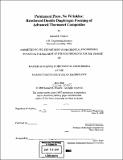Permanent press, no wrinkles : reinforced double diaphragm forming of advanced thermoset composites
Author(s)
Truslow, Samuel B. (Samuel Blagden), 1972-
DownloadFull printable version (19.88Mb)
Alternative title
Reinforced double diaphragm forming of advanced thermoset composites
Other Contributors
Massachusetts Institute of Technology. Dept. of Mechanical Engineering.
Advisor
Timothy G. Gutowski.
Terms of use
Metadata
Show full item recordAbstract
Structures made out of advanced composite materials have significant advantages over those made from metals. The chief advantages are high strength-to-weight ratio, the ability to tailor mechanical properties, high fatigue resistance and good corrosion resistance. The manufacturing methods used to produce these materials are different from those used to produce metal parts. Composite structures are made from numerous layers of fibrous material which must be prevented from wrinkling during manufacturing to maintain optimal mechanical properties. Manufacturing composite parts without wrinkling can be very difficult when the part has double curvature. In these cases there will be a tendency for the parts to wrinkle as they are shaped. Due to these difficulties many parts are made by hand. This method carries two penalties in that is much slower, and therefore more expensive, than automatic methods and it involves significant hand manipulation of the material resulting in the potential for serious repetitive stress injuries in the workers. The double diaphragm forming process was developed to allow parts of significant double curvature to be made faster and with little hand work. The process involves creating a flat stack of all the layers of material and then forming it into shape between two rubber diaphragms in one step. This process was adapted to a family of structural composite parts, called rib chords, in the Boeing 777 airliner vertical fin and horizontal stabilizer. These parts have considerable double curvature and so present opportunities for large improvements in production rate and ergonomic suitability. Development of a reinforced version of double diaphragm forming has created significant cost savings for manufacturing these parts. A production machine was designed and built to match this process to the production environment for the rib chords. Use of the machine reduces the part flow time by 70% (Boeing's figure) which translates to significant direct cost savings. The process also reduces the potential for worker injuries dramatically. Not only is the processing improved but significant factory floor space and fabricating equipment are freed up since the one machine can make production quantities easily. Finally the process is very well suited for use in an automated production system creating the opportunity for even more savings in the future.
Description
Thesis (S.M.)--Massachusetts Institute of Technology, Dept. of Mechanical Engineering, 2000. Includes bibliographical references (leaf 105).
Date issued
2000Department
Massachusetts Institute of Technology. Department of Mechanical EngineeringPublisher
Massachusetts Institute of Technology
Keywords
Mechanical Engineering.